Top 10 Poetic Devices in English
Welcome to the post “Top 10 Poetic Devices in English. Have you ever been captivated by a poem, transported by its words to a faraway land or a deep emotion? The magic behind this experience lies in Poetic Devices in English. These are the tools that poets wield to transform everyday language into something extraordinary. From creating vivid imagery to evoking powerful emotions, poetic devices breathe life into words, allowing them to dance, sing, and resonate with the reader on a profound level.
Understanding these devices unlocks a deeper appreciation for poetry, transforming you from a passive reader to an active participant in the poet’s world. Throughout this exploration, we’ll delve into the various categories of Poetic Devices in English, unveil their secrets, and witness their power in action through captivating examples. Get ready to embark on a journey where language takes flight, and the magic of poetry unfolds!
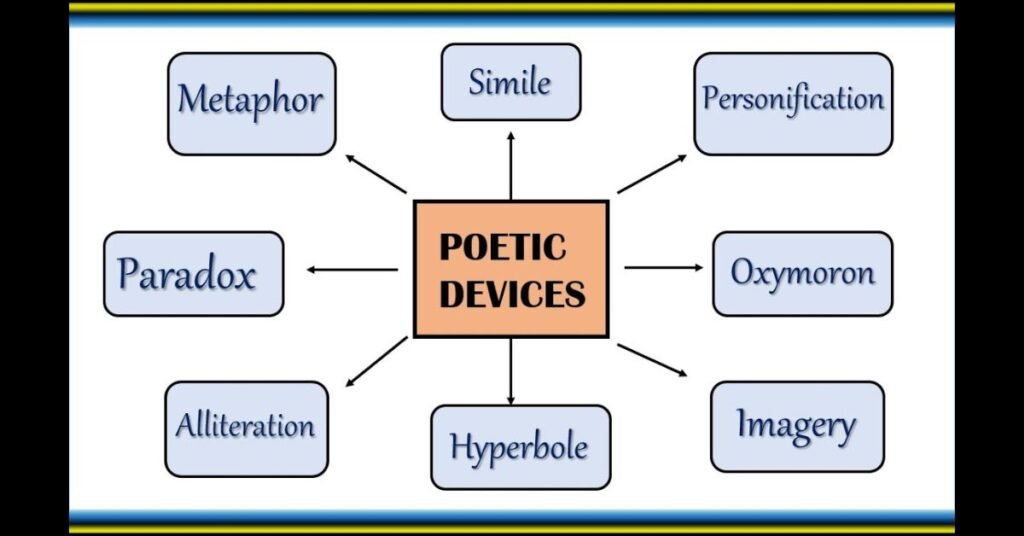
I. Figurative Language: Beyond the Literal
Figurative language goes beyond the literal meaning of words, creating comparisons and connections to paint a more vivid picture or express complex ideas in a fresh way. Here are some key players:
- Simile
A direct comparison using “like” or “as.”
Example: “Her eyes twinkled like stars in the night sky.” (This compares the brightness and beauty of the eyes to stars.)
- Metaphor
An indirect comparison where one thing becomes another.
Example: “The world is a stage, and we are merely players.” (This doesn’t literally mean the world is a physical stage, but suggests life is a performance.)
- Personification
Giving human qualities to non-human things.
Example: “The wind whispered secrets through the trees.” (The wind doesn’t have a mouth, but personifying it creates a sense of mystery.)
When to use this Poetic Device
Use figurative language whenever you want to add vivid imagery, express a complex idea in a relatable way, or evoke a specific emotion.

II. Sound Devices: The Music of Words
Poets understand the power of sound. Here’s how they use sounds to enhance their poems:
- Rhyme
Matching sounds at the end of words creates a sense of rhythm and musicality.
Example: “The roses are red, the violets are blue.” (Simple rhyme scheme using “red” and “blue”.)
-
Rhythm
The pattern of stressed and unstressed syllables in a line creates a musical flow.
Example: “I WANDERED LONELY AS A CLOUD” (from “I Wandered Lonely as a Cloud” by William Wordsworth) – This line has a clear stressed-unstressed pattern that creates a sense of movement.
- Alliteration
Repetition of consonant sounds at the beginning of words.
Example: “Peter Piper picked a peck of pickled peppers.” (The “p” sound is repeated for emphasis.)
- Assonance
Repetition of vowel sounds within words.
Example: “The cold sea breeze blows.” (The “o” sound is repeated.)
- Onomatopoeia
Words that imitate the sounds they describe.
Example: “The crack of thunder echoed through the valley.” (“Crack” mimics the sound of thunder.)
When to use this Poetic Device
Use rhyme to create a catchy rhythm or emphasize certain words. Use rhythm to set the mood and pace of the poem. Alliteration, assonance, and onomatopoeia add emphasis, create a sense of playfulness, or imitate sounds in the poem.
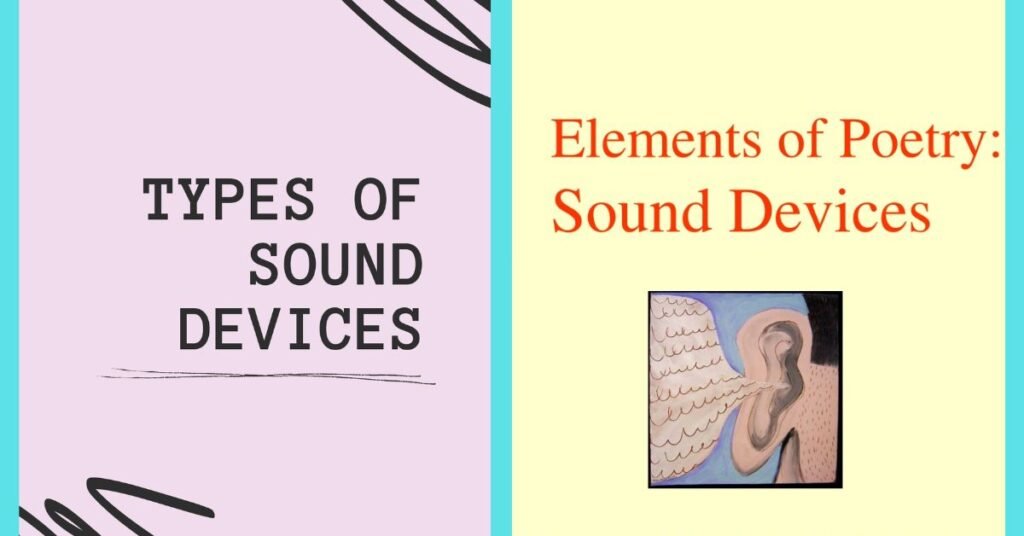
III. Structure and Form: Shaping the Poem
The way a poem is structured also contributes to its meaning and impact. Let’s explore some key structural devices:
- Stanza
A group of lines that form a basic unit of a poem, like a paragraph in prose.
- Couplet
A stanza with two lines.
Example: “The curfew tolls the knell of parting day, / The lowing herd winds slowly o’er the lea.” (from “Elegy Written in a Country Churchyard” by Thomas Gray)
- Tercet
A stanza with three lines.
- Quatrain
A stanza with four lines. Many poems use quatrains, like the famous “Rubaiyat” by Omar Khayyam.
- Sonnet
A specific form with 14 lines and a particular rhyme scheme.
When to use this Poetic Device
The choice of stanza and form depends on the poem’s theme and the poet’s desired effect. A sonnet, for example, is often used for expressing complex emotions.

IV. Other Poetic Devices: Expanding the Palette
There’s more to poetic devices than just these categories. Here are some additional gems:
- Imagery
Using vivid descriptions to create a mental picture in the reader’s mind.
Example: “The golden leaves danced in the crisp autumn breeze.”
- Symbolism
Using objects, colors, or actions to represent something deeper or more abstract.
Example: A red rose can symbolize love, while a broken mirror can symbolize shattered dreams.
When to use this Poetic Device
Symbolism adds layers of meaning and allows readers to connect with the poem on a deeper level.
- Hyperbole
Exaggeration for emphasis or effect.
Example: “I’m so hungry I could eat a horse!” (This is obviously an exaggeration.)
- Litotes
Understatement for emphasis.
Example: “She wasn’t too happy about that.” (This implies she was quite unhappy.)
When to use this Poetic Device
Use hyperbole and litotes to create a strong impression and emphasize emotions.
- Juxtaposition:
Placing contrasting ideas or images side-by-side to create a powerful effect.
Example: “The palace walls shimmered with gold, while the poor huddled in the shadows.” (This highlights the vast difference between the rich and the poor.)
- Paradox:
A statement that seems contradictory but may hold some truth.
Example: “Silence can speak volumes.” (This seems contradictory, but silence can be very expressive.)

When to use this Poetic Device
Use juxtaposition and paradox to surprise the reader and make them think about the poem in a new light.
- Enjambment
Lines that run on without a pause at the end, creating a sense of flow and movement.
Example: “The fog comes / on little cat feet.” (from “Fog” by Carl Sandburg) – The first line doesn’t end with a complete thought, creating a sense of mystery.
- Caesura
A pause within a line of poetry, often marked by punctuation.
Example: “He paused, / a long, considering pause.” (The caesura after “paused” emphasizes the length and thoughtfulness of the pause.)
When to use this Poetic Device
Use enjambment to create a sense of forward motion and caesura to add emphasis or create a dramatic pause.
- Apostrophe
Addressing someone or something absent as if they were present.
Example: “Oh, cruel fate!” (The speaker is addressing fate, even though it’s not a person.)
- Rhetorical Question
A question not meant to be answered literally, but to make a point.
Example: “Can’t you see how much I love you?” (This doesn’t expect a literal answer, but expresses the speaker’s strong feelings.)
When to use this Poetic Device
Use apostrophes and rhetorical questions to directly engage the reader or to emphasize a strong emotion.
V. Putting it All Together: Using Poetic Devices Effectively
Now that you’ve explored a variety of poetic devices, let’s see how they work together to create a powerful effect.
Consider this example:
The rusty (adjective – adds detail) wind whispered (verb – personification) secrets through the bare (adjective – imagery) branches, a lonely lament (noun – symbolism) for the summer’s lost (adjective – emphasizes change) warmth.
This short passage uses several devices:
- Imagery: “rusty wind,” “bare branches”
- Personification: “Wind whispered”
- Symbolism: “lament” for summer’s warmth
- Adjectives: “rusty,” “bare,” “lost” (add detail and emphasize change)
These devices work together to create a vivid picture of a lonely scene and evoke a sense of melancholy for the passing summer.

Conclusion
As we wrap up our exploration of Top 10 Poetic Devices in English, it’s clear that these tools are the poet’s brushstrokes, painting vivid pictures with words and weaving emotions into the very fabric of the poem. By mastering these devices, poets can elevate their craft from simple storytelling to a captivating dance of language, sound, and meaning.
Remember, the best poems aren’t just a string of words; they’re a symphony of Poetic Devices working together. A well-placed metaphor can spark a reader’s imagination, while a touch of alliteration adds a playful rhythm. Don’t be afraid to experiment! The beauty of Poetic Devices lies in their versatility. You can use them subtly to enhance the poem’s natural flow, or you can weave them together to create a dazzling display of language.
The next time you encounter a poem, take a moment to appreciate the top 10 Poetic Devices in English. Devices at play. Look for the metaphors that paint a thousand words, the similes that create relatable comparisons, and the rhythm that carries you through the poem’s journey. By understanding these Top 10 Poetic Devices in English, you’ll unlock a deeper appreciation for the artistry and power of poetry. So, the next time you pick up a poem, remember – it’s not just a collection of verses; it’s a canvas splashed with the vibrant colors of Poetic Devices.


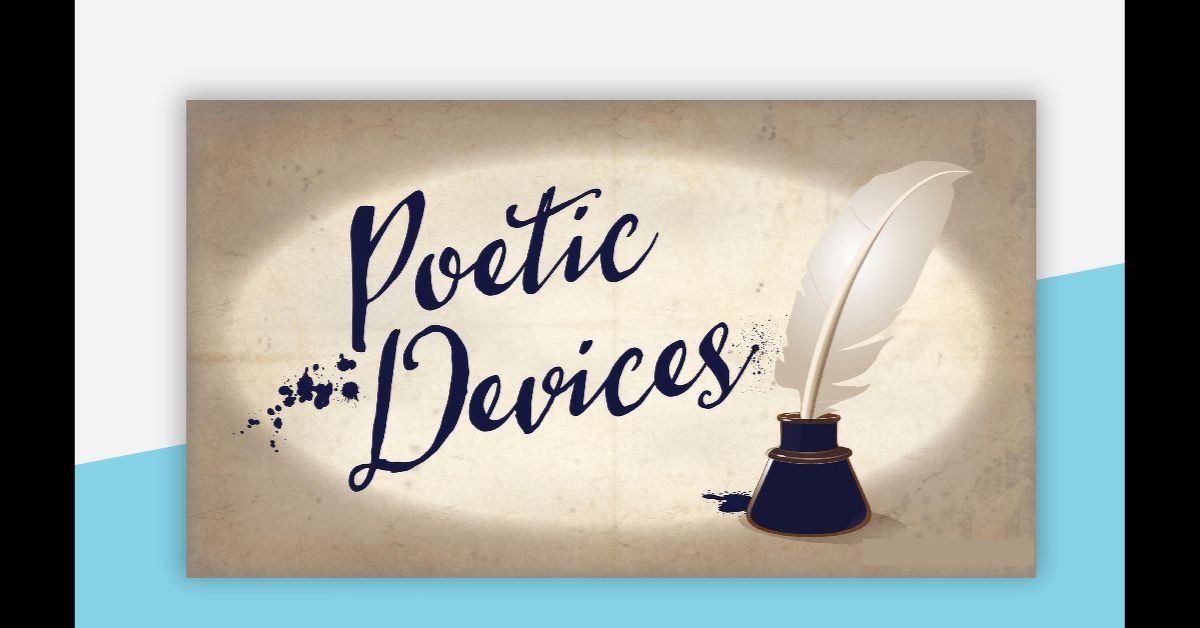

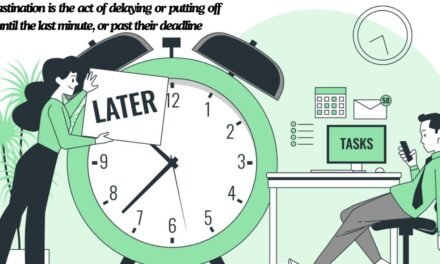
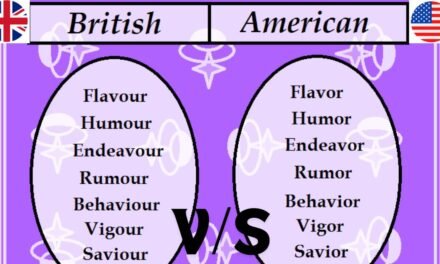


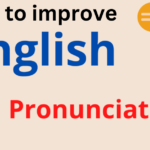
I discovered your blog site on google and check a few of your early posts. Continue to keep up the very good operate. I just additional up your RSS feed to my MSN News Reader. Seeking forward to reading more from you later on!…
Great tremendous issues here. I am very happy to peer your article. Thanks so much and i’m looking forward to contact you. Will you kindly drop me a e-mail?
This web site is really a walk-through for all of the info you wanted about this and didn’t know who to ask. Glimpse here, and you’ll definitely discover it.
Howdy! I’m at work browsing your blog from my new iphone 3gs! Just wanted to say I love reading through your blog and look forward to all your posts! Keep up the great work!
I truly appreciate this post. I¦ve been looking all over for this! Thank goodness I found it on Bing. You have made my day! Thanks again
you have a great blog here! would you like to make some invite posts on my blog?
I and also my friends were found to be following the great information from your site and so instantly developed a terrible suspicion I had not thanked you for those techniques. All of the people had been certainly thrilled to see all of them and have in effect honestly been loving these things. Thank you for actually being very helpful and for considering varieties of beneficial themes most people are really wanting to be aware of. Our honest apologies for not expressing gratitude to you earlier.